Your progress
0%
complete
Implementing and monitoring a CBR programme involves the following steps. Note that these steps need not be performed in the order listed.
Use your mouse or keyboard to expand each of the headings below. To add an activity to your action plan, select the Add button beside it.
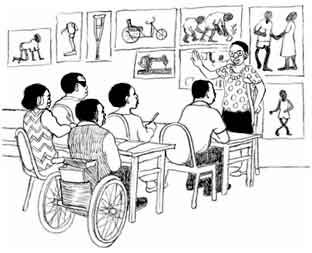
The first part of the implementation stage is to use the programme plan and, with the help of the team and other stakeholders, develop a detailed work plan. The work plan will specify:
It is helpful to summarize all the information in a work plan in a graph or tabular format. This provides a clear visual outline or illustration. A common format used is a Gantt chart (see below).
Gantt chart for an income-generating project

Several “open source” computer software programmes are available for creating work plans. Many of these programmes can display work plans in Gantt chart format.
Select any of the links below to learn more about or download open source planning tools:
Note: WHO does not specifically recommend or endorse the use of any of the above-mentioned programming tools.
Implementation involves mobilizing and managing several types of resources – financial, human, material and in-kind resources. To facilitate the mainstreaming of CBR, it is important to consider how much of each of these resource types will come from a mainstream partner or programme, and how much will need to be provided by the CBR programme.
Fundraising: It is essential to seek financial resources to develop new programmes, or to enable existing programmes to continue or revitalize their work. Financing for CBR programmes may be mobilized from many different sources. Where possible, the emphasis should be on community-based funding and government funding, as these will help the longer-term sustainability of programmes.
Possible sources of funding in the community may include:
It is important to work with government officials at all levels to ensure that provisions for CBR funding have been included in all relevant budgets. In addition, social audits of government-provided funding are a useful tool for determining what resources have been allocated to planned activities, and whether these expenditures have been used effectively and as planned. Social audits can often generate additional revenue, and also provide an opportunity to build contacts with funding organizations.
To learn more about social audits, select the following link: Social audit guide (from the Open Society Initiative for Eastern Africa)
If sufficient resources are not available locally, fundraising may be required at regional, national or international levels to develop and implement CBR programmes.
Financial management: Establishing a transparent system for managing finances is very important. This will ensure that your programme is accountable to all stakeholders, including funding bodies, community members and people with disabilities themselves. Financial management is a key role of the programme manager, but others may be involved, particularly when programmes are large and involve large sums of money.
Financial management involves:
Human resources
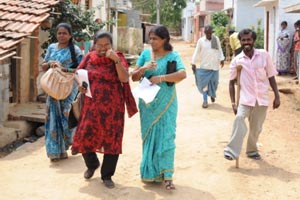
Recruitment: When recruiting CBR programme managers and personnel, it is better to hire staff members from the local community, if possible, as this will ensure they have good knowledge of the local culture and language and better access to community members.
CBR programmes should also be strongly committed to recruiting people with disabilities or their family members, because this shows a commitment to the principles of CBR (see CBR today in the Introduction module) and contributes to their empowerment. In all cases, people should be recruited on the basis of their knowledge, skills and ability to perform the job. Job descriptions should be prepared before the recruitment process. These usually outline the roles and responsibilities of the job and the experience needed.
See how a physiotherapist with a physical disability is working to help others improve their lives in India.

To learn more about how to recruit and work effectively with people with disabilities, select the following links:
Some CBR programmes may also consider recruiting volunteers, particularly where resources are limited. There may be many people in the community who are willing to work voluntarily for CBR programmes – people with disabilities, family members, students and professional people – in order to perform services that will bring desired changes to the community. Volunteers are not paid for their work, but usually receive incentives and resources to help them do their jobs.
It is important to consider both the advantages and disadvantages of recruiting volunteers. For example, while volunteers usually have good local knowledge and are cost-effective, they often have limited time, and volunteer turnover can be high.
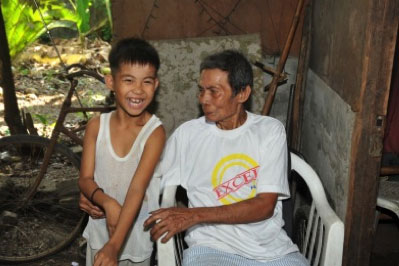
Training: CBR programme managers and personnel require a wide range of knowledge and skills to enable them to carry out their roles and responsibilities (see also Stage 1: Stakeholder analysis).
CBR programmes should work to ensure that training standards are in place to ensure a minimum level of competency throughout the CBR community.
It may be necessary for CBR programmes to update and strengthen existing training programmes or develop new training initiatives.
Throughout the world, a wide range of CBR training programmes are available for both programme managers and personnel. They differ in their content and duration and are offered by a variety of providers. For example, in some countries, tertiary institutions offer diploma courses for CBR personnel, whereas in other countries training programmes may not be accredited and only last for a few weeks or months.
Training for CBR workers aims to improve their capacity to deliver high-quality services to people with disabilities and their family members. Training may cover a wide range of areas, including:
Where suitable training programmes already exist, CBR programmes can conserve resources by coordinating training needs with these programmes. When selecting training courses for CBR personnel, it is important to consider carefully what content is appropriate. Quite often training courses are based on courses designed for rehabilitation professionals, such as physiotherapists or occupational therapists. As a result, these courses are often inappropriate and unrealistic for CBR staff members, as they focus on the development of high-level clinical and technical skills instead of the skills needed for community development.
Training for CBR programme managers – including this online course – aims to build up their capacity for effective and efficient management of programme activities. It is important that programme managers are familiar with the four stages of the management cycle, which are crucial to the success of programmes. Managers also need to have a deep understanding of disability as well as CBR strategy.
Learn about the CBR diploma programme that has been created at the College of Higher Education in the Solomon Islands


The Solomon Islands National University now offers a Diploma of Community Based Rehabilitation, which is based on the CBR strategy. It aims to equip graduates with skills and knowledge to implement CBR strategies at a provincial level. This two-year course covers the following areas:
Following completion of this course, graduates have the skills and knowledge necessary to work in the CBR Unit (Ministry of Health and Medical Services), as fieldworkers in the provinces, or as therapy assistants attached to hospitals.
Outside the health sector, the education system and non-governmental organizations have also been identified as potential areas of work.
Staff development, support and supervision: Staff development and ongoing training is important to enable CBR programme managers and personnel to renew their existing skills and develop new skills as necessary. Often, resources that are available in local communities can be utilized for ongoing training, such as by existing training courses, training materials from other organizations and experts in relevant areas.
Employing people with disabilities as expert consultants in staff development activities offers a number of important benefits – namely, it enables people with disabilities to:
Some CBR programmes may not be successful because they fail to provide enough support and supervision for their staff. CBR personnel are the backbone of CBR programmes, and managers therefore need to ensure that they are listened to and supported in their roles. Providing support and supervision involves establishing clear supervision and reporting lines, making sure personnel are aware of their roles and responsibilities, and undertaking regular performance reviews. It is important that programme managers watch for “burnout”, which may occur when CBR personnel take on too much work, too intensively and for too long.
Material and In-kind resources
In-kind donations of materials and services are an important and often substantial source of resources for CBR programmes.
In-kind donations, such as assistance with coordination of transport, are usually sought and obtained from community members in relation to specific activities, such as during vision and hearing check-up camps or the celebration of the International Day of Persons with Disabilities.
The programme manager should be very familiar with the work plans and be able to make the necessary preparations to ensure that all the activities are carried out as planned. A detailed description of CBR activities will not be provided here, as these are included in each of the other modules in this online course. The activities generally fall under the following main areas:
Use your mouse or keyboard to expand each of the headings below.
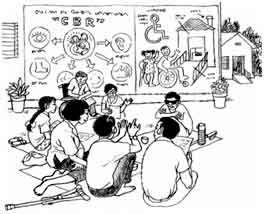
Awareness-raising activities used in CBR are directed at key stakeholders to provide information and knowledge about disability and thus generate attitudinal and behaviour change. They are explicitly mentioned in the CRPD as essential for the recognition of human rights for persons with disabilities.
They are also used to generate support for the CBR strategy and programmes and to encourage stakeholder involvement and participation.
Coordination and networking activities are needed to build good relationships and partnerships with CBR stakeholders.
They are important activities for sharing knowledge and resources, reducing duplication and mobilizing community effort.
The ultimate goal of all CBR programmes is to ensure full inclusion through complete and effective participation in mainstream services and other opportunities in the community. Therefore, activities to facilitate mainstreaming are central to the CBR agenda and ensure that people with disabilities can participate fully, and be supported to do so, within each development sector, and specifically within the health, education, livelihood and social sectors. Mainstreaming activities presume that specific measures of reasonable accommodation and accessibility are undertaken in order to make participation of people with disabilities complete and realistic.
Each CBR programme will provide a range of services, depending on the parts of the CBR matrix the programme chooses to focus on. Many of the activities associated with service provision are implemented by CBR personnel. Activities may range from identification of people with disabilities and referrals to mainstream or specialized services to the provision of basic rehabilitation and simple assistive devices.
Historically, CBR programmes have overlooked advocacy and focused instead on service provision for people with disabilities.
There are many types of advocacy activities that can be used to ensure that equal opportunities and rights for people with disabilities are achieved in the health, education, livelihood and social sectors as well as in other aspects of community life. Among the tools that can be used to increase social accountability are:
To learn more about these tools, select the following links:
Building the capacity of key stakeholders will ensure that they have adequate knowledge and skills to carry out their roles and responsibilities (see also Stage 1: Stakeholder analysis). Training is one way to build the capacity of key stakeholders, and is mentioned as a suggested activity throughout this online course. Not all stakeholders require the same type or level of training; training should be based on their expected roles and responsibilities and the needs that arise from these. Some stakeholders may only require short workshops, seminars or briefing sessions to sensitize them to disability issues and orient them to the CBR strategy. Others may require formal training programmes.
CBR programmes should identify existing training programmes in the community to conserve and maximize their resources. Possible training resources may include:
Training others to deliver CBR training is also important, to ensure that a pool of people with a good knowledge of CBR and the skills to teach it to others is always available at the local level.
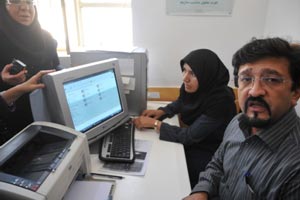
What is monitoring?
Monitoring keeps track of programme activities. It involves the regular collection and analysis of information throughout the implementation stage.
Monitoring is an internal function of the programme, carried out by CBR programme managers and personnel with input from people with disabilities served by the programme. It helps the team to identify which activities are going well and which are not, so that the necessary changes can be made. When good monitoring systems are in place and are effective, evaluation of the programme becomes much easier (see Stage 4: Evaluation).
Steps involved in monitoring
Stage 2: Planning and design
Deciding how to collect information: Decisions on how to collect monitoring information (sources of verification) should also have been made in Stage 2: Prepare a programme plan.
Collecting and recording information: Formal systems should be in place to collect and record information. It is important that these systems be as simple as possible, and that they collect only the information that is needed. Staff will need to be trained on how to use data collection forms correctly, either formally or by such informal means as keeping detailed notes about their activities in a notebook or diary. It is important to ensure that there is a regular daily, weekly monthly or quarterly schedule for information collection. Where possible and acceptable, using pictures or videos as evidence can help bring evidence to life during monitoring conversations.
Analysing information: Collecting and recording information is often much easier than analysing it. However, if CBR programme managers do not look closely at the information, they will not be able to observe the progress of the programme activities and identify any potential problems. After analysing the information, it may be necessary to carry out further investigations to find out what is really going on.
Effective analysis requires summarizing the information that is received from multiple sources and looking for trends. If trends exists, the programme manager, using his or her experience, needs to determine what the trend means or what it implies for the programming. Once this is decided, the results can be discussed with key stakeholders.
Reporting and sharing information: Reporting and sharing the results of monitoring with key stakeholders shows that the programme is transparent and accountable. Periodic reports should be compiled and distributed to key stakeholders. The report should include information on the activity or work area of interest, the work that was planned and how much of it was completed, and what progress has been made toward reaching the programme outcomes. The report should also include the budgeted resources compared to the actual expenditure and the constraints or problems that have been experienced. Finally, the report can detail the actions taken, or recommended, and the lessons learned from the experience.
Managing information: Documents, reports, correspondence and accounts will be generated from a CBR programme. Since this is a lot of information, an efficient computer-based or paper-based filing system should be set up to manage information. This will save a great deal of time and prevent misunderstandings during monitoring. If confidential information is being collected, it is important to ensure that this is stored in a secure place.